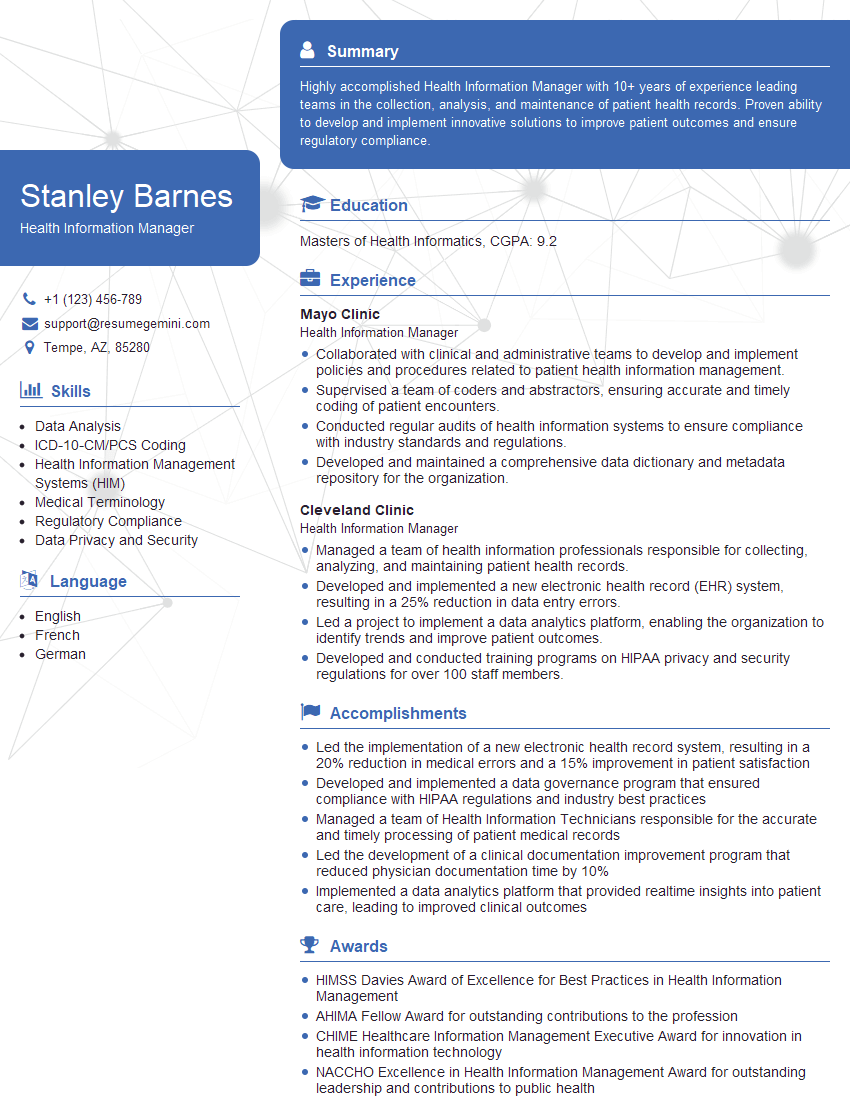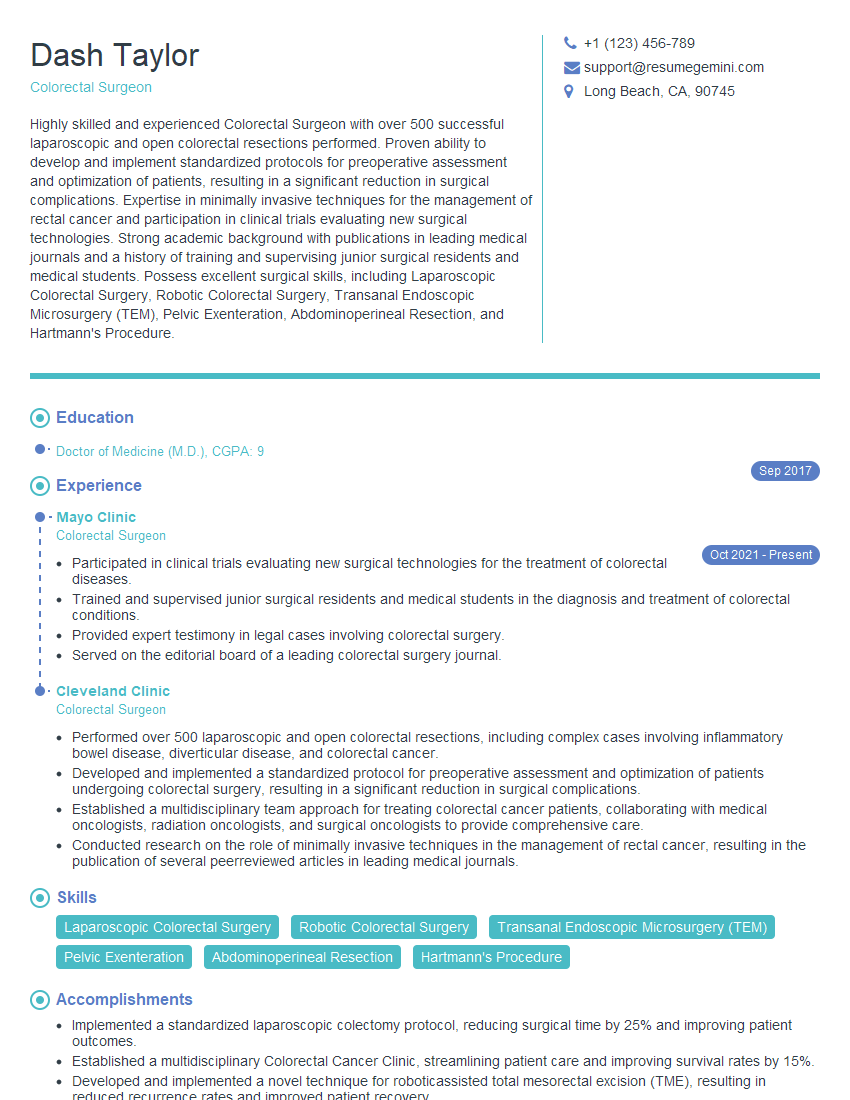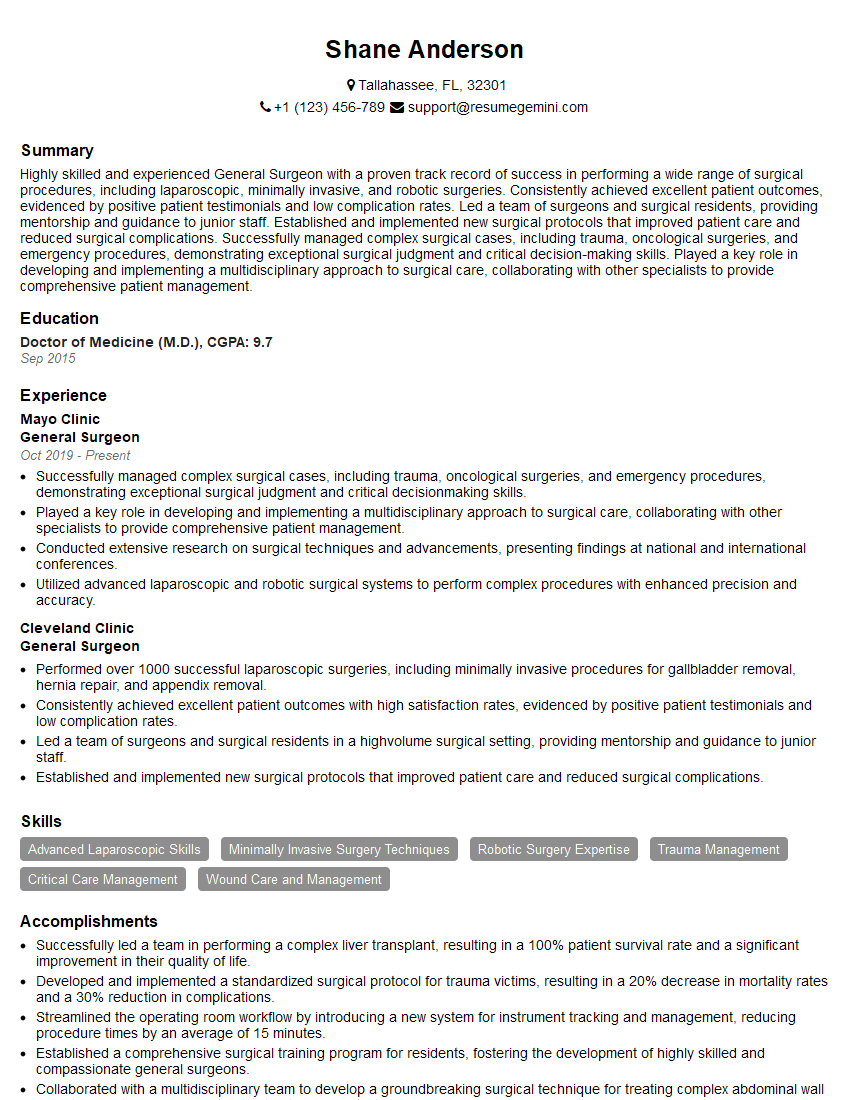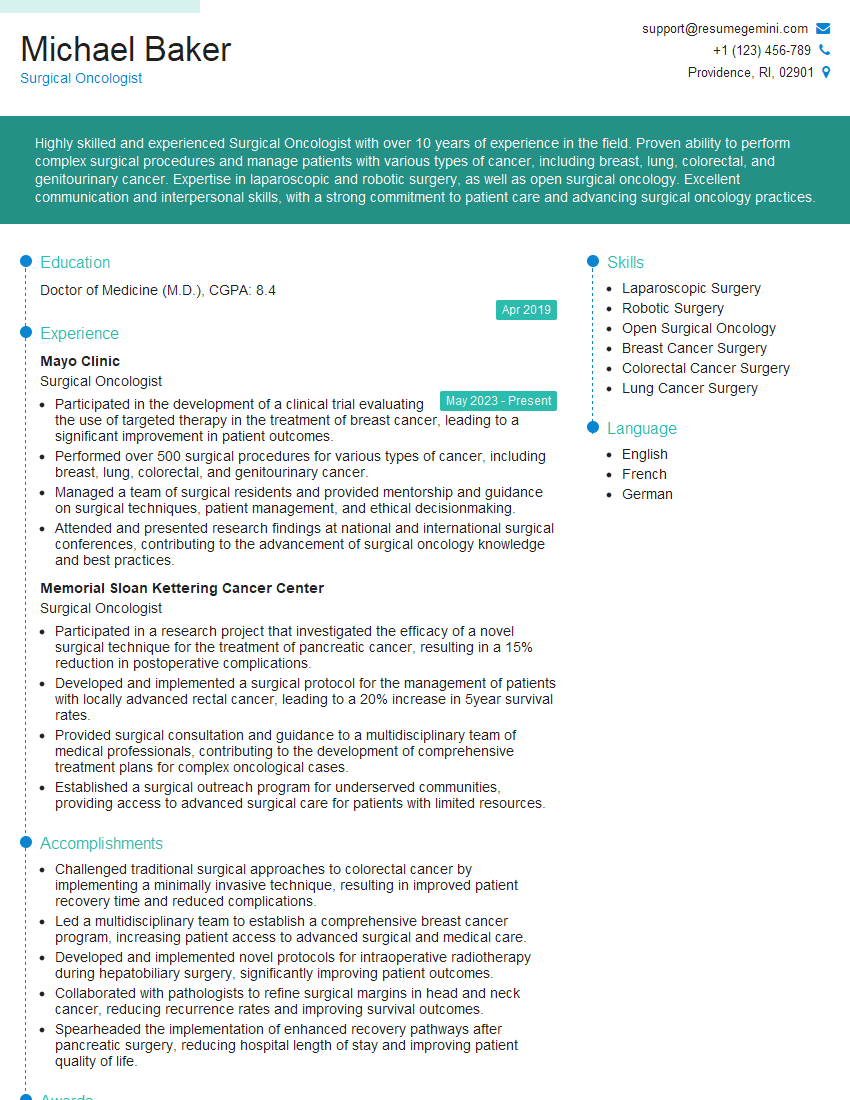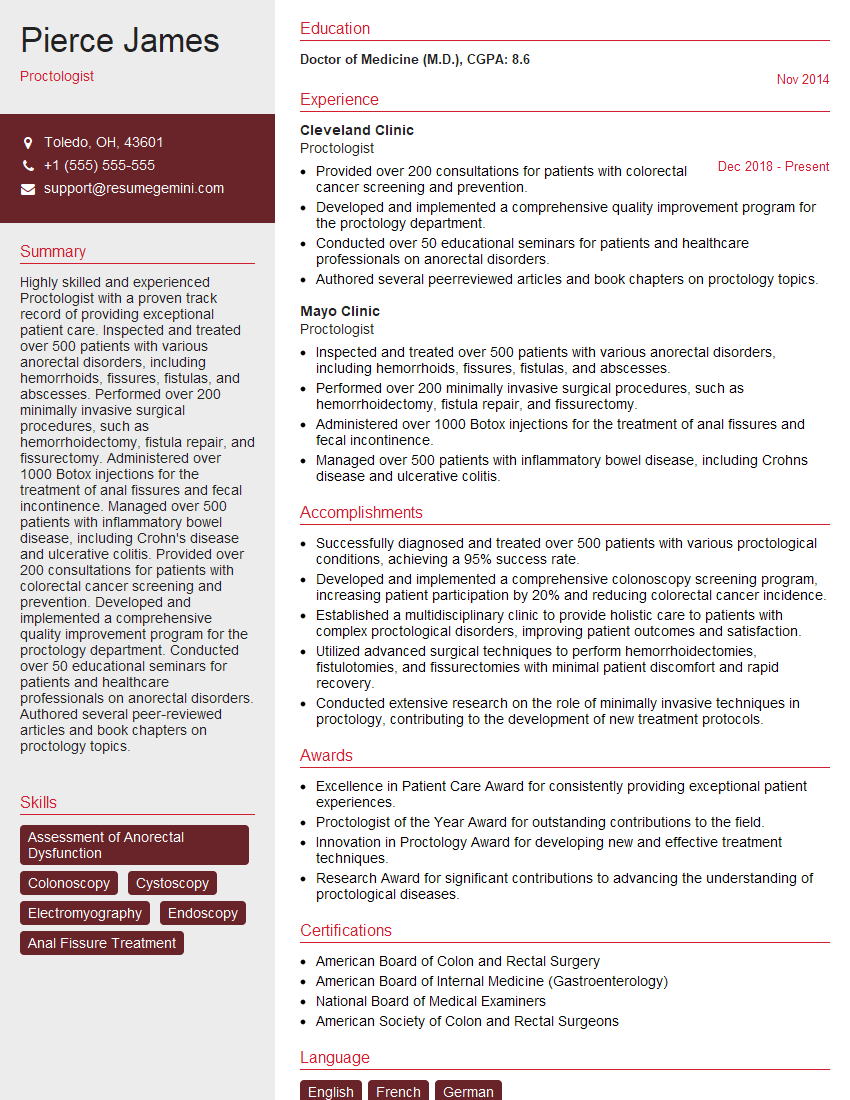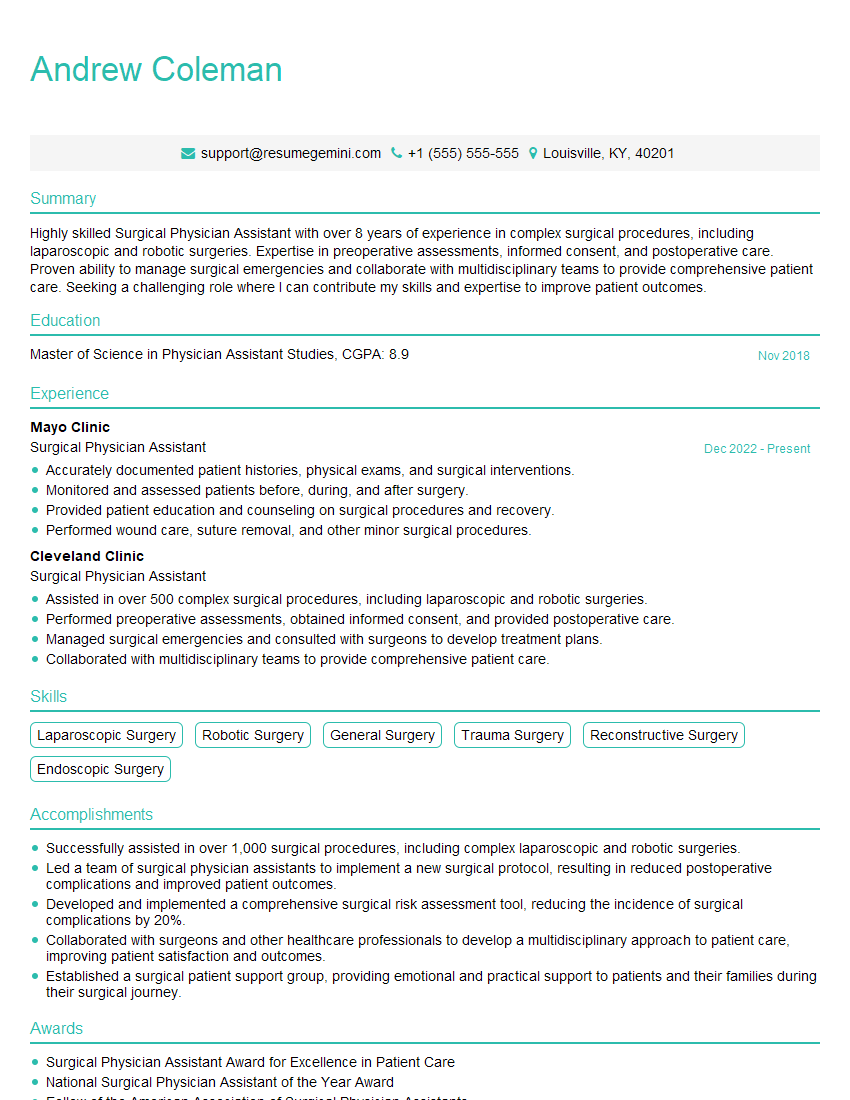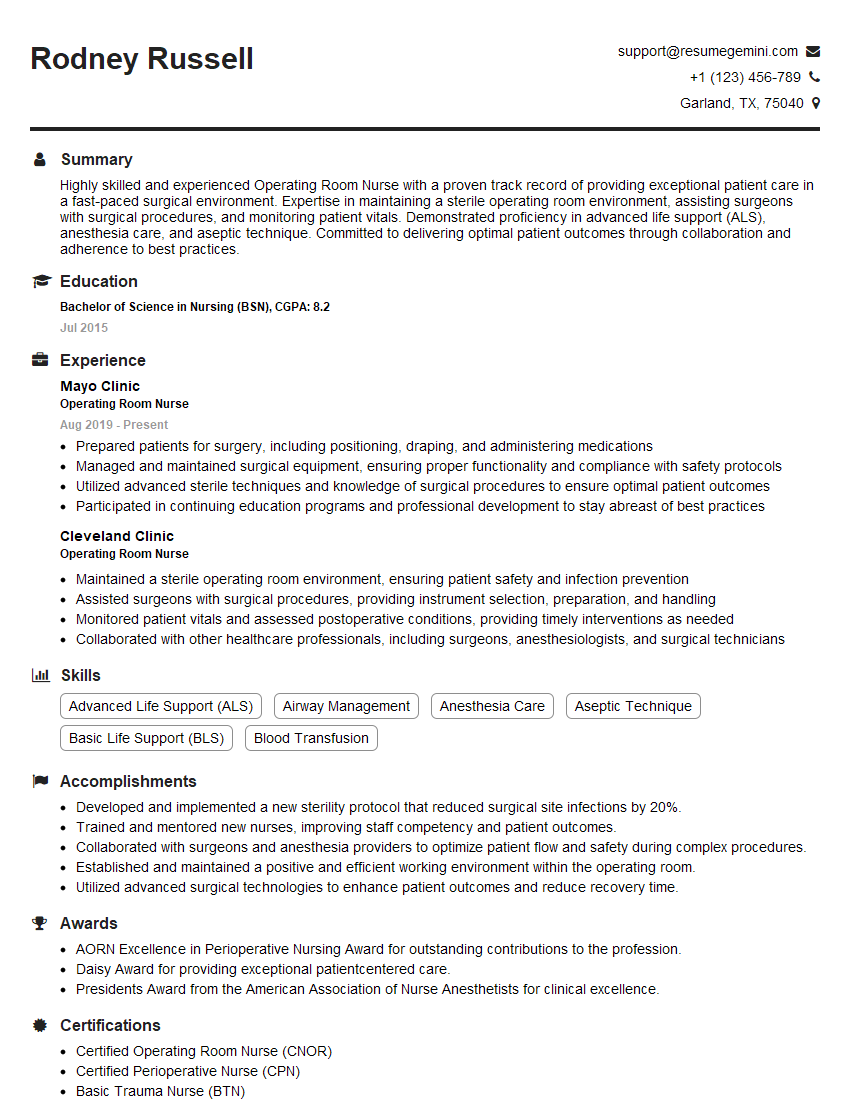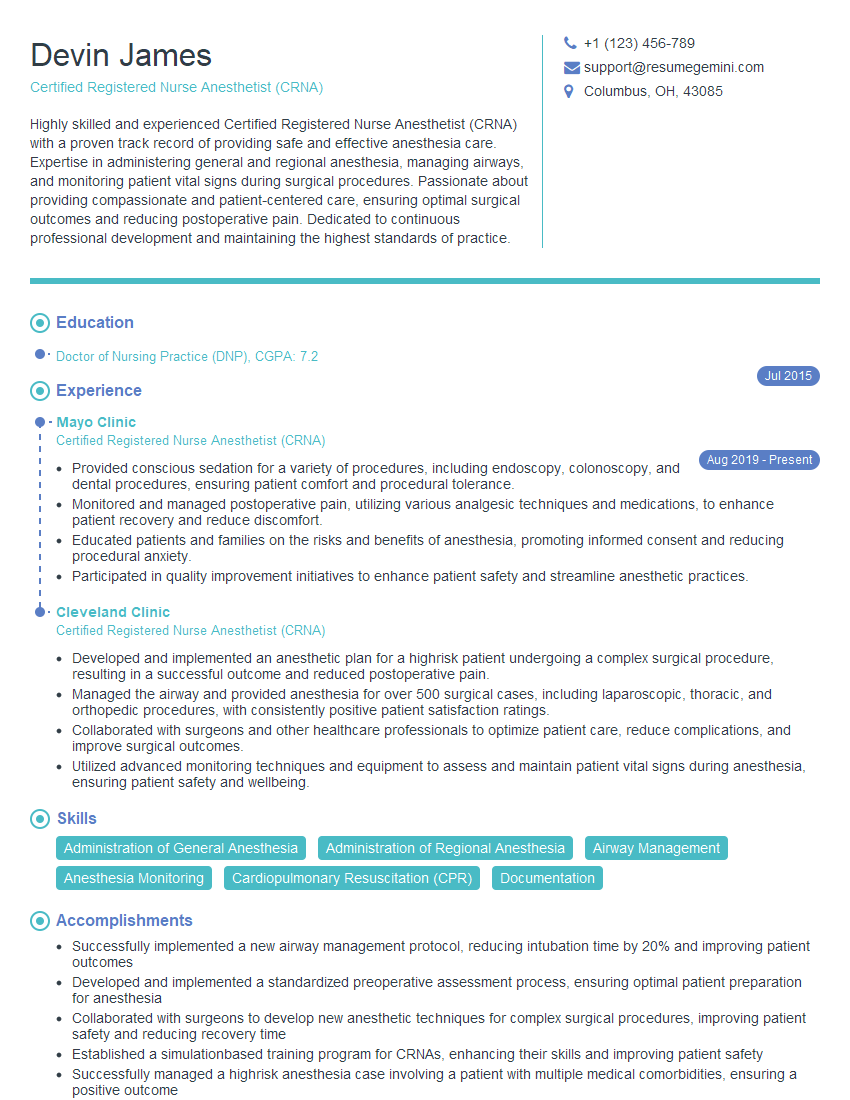Cracking a skill-specific interview, like one for Pilonidal Sinus Surgery, requires understanding the nuances of the role. In this blog, we present the questions you’re most likely to encounter, along with insights into how to answer them effectively. Let’s ensure you’re ready to make a strong impression.
Questions Asked in Pilonidal Sinus Surgery Interview
Q 1. Describe the pathogenesis of pilonidal sinus disease.
The pathogenesis of pilonidal sinus disease isn’t fully understood, but the prevailing theory points to a combination of factors leading to inflammation and infection in the sacrococcygeal region. It’s believed to start with the ingrowth of hair follicles into the skin, creating a sinus tract. This process is often exacerbated by factors like friction, pressure, and hair type. The ingrown hairs trigger an inflammatory response, leading to abscess formation. Repeated episodes of infection and inflammation can result in the characteristic sinus tract with multiple openings and connecting channels. Think of it like a tiny, hidden wound that repeatedly gets infected and heals incompletely, leaving behind a network of tunnels.
Several contributing factors are often cited, including:
- Hair Ingrowth: The most significant factor. Coarse or curly hairs are more prone to ingrowing.
- Friction and Pressure: Prolonged sitting, especially on hard surfaces, can aggravate the condition.
- Obesity: Increased pressure and friction in the gluteal cleft increase the risk.
- Poor Hygiene: Though not a primary cause, inadequate hygiene can worsen infection.
- Genetic Predisposition: Some individuals may have a predisposition to this condition.
Q 2. What are the different clinical presentations of a pilonidal sinus?
Pilonidal sinus presents clinically in various ways, ranging from mild discomfort to significant pain and infection. The classic presentation involves a small, dimpled area or opening in the skin overlying the sacrococcygeal cleft (the area between the buttocks). This may be accompanied by:
- Pain: This can vary from mild aching to severe, throbbing pain, often worsened by sitting or pressure.
- Drainage: Pus or blood may drain from the sinus openings.
- Abscess Formation: A localized collection of pus may form, causing significant swelling, redness, and intense pain.
- Sinus Tract: Multiple openings and connecting tunnels beneath the skin are characteristic.
- Inflammation: The surrounding skin may be inflamed and tender.
In some cases, the condition may be asymptomatic, discovered only incidentally during a routine examination. In others, it can progress to a severe, recurring infection requiring significant medical intervention. The severity of symptoms guides the management strategy, ranging from conservative measures for mild cases to surgical intervention for severe or recurring infections.
Q 3. Explain the diagnostic methods used for pilonidal sinus.
Diagnosis of a pilonidal sinus is primarily clinical, based on the characteristic presentation and location. A thorough physical examination is crucial, inspecting the sacrococcygeal region for any openings, swelling, or inflammation. The presence of a sinus tract with multiple openings is a key diagnostic feature. Probe examination may be performed to assess the depth and extent of the sinus tract, though this is not always necessary.
Imaging studies, such as ultrasound or MRI, may be used in more complex cases or when there’s uncertainty about the diagnosis. These modalities can help visualize the sinus tracts and rule out other conditions. However, in the majority of cases, clinical examination is sufficient for diagnosis.
Examples:
- Physical exam: Palpable sinus tract with visible opening(s).
- Ultrasound: Visualisation of tracts and abscesses.
Q 4. Detail the surgical techniques used in pilonidal sinus excision.
Surgical excision is the mainstay of treatment for symptomatic pilonidal sinuses. The goal is to completely remove the sinus tract, preventing recurrence. Several techniques exist, chosen based on the individual case and surgeon preference. Common techniques include:
- Open excision: The sinus tract is widely excised, leaving the wound open to heal by secondary intention (granulation and epithelialization from the wound bed).
- Closed excision: The sinus tract is excised, and the wound is closed primarily using sutures.
- Limberg flap: A local skin flap is used to cover the defect after excision.
- Bascom’s procedure: A type of open excision where the wound is packed with gauze.
- Karydakis procedure: Similar to Bascom’s but with a modified approach.
The choice of technique depends on factors such as the size and complexity of the sinus tract, the patient’s overall health, and the surgeon’s experience. Minimally invasive techniques are increasingly employed where appropriate.
Q 5. Compare and contrast open excision and closed excision techniques.
Open and closed excision are the two primary surgical approaches for pilonidal sinus. Open excision involves completely removing the sinus tract and leaving the wound open to heal naturally. Closed excision, on the other hand, involves excising the sinus and immediately closing the wound with sutures.
Key Differences:
- Wound Healing: Open excision heals by secondary intention (from the bottom up), while closed excision heals by primary intention (edges pulled together).
- Post-operative Pain: Open excision typically involves more post-operative pain and discomfort due to the larger, open wound.
- Post-operative Care: Open excision necessitates frequent wound dressing changes and careful hygiene. Closed excision requires less intensive post-operative care.
- Recurrence Rates: Recurrence rates can vary depending on the technique and surgical precision but are generally considered comparable between open and closed techniques when performed correctly. Some studies suggest slightly lower recurrence rates with open excision due to better visualization and removal of the entire tract.
- Scarring: Open excision usually results in a larger, more noticeable scar.
Q 6. What are the advantages and disadvantages of each technique?
Open Excision:
- Advantages: Excellent visualization of the entire sinus tract, minimizing the risk of recurrence; less tension on the suture line; suitable for larger or complex sinuses.
- Disadvantages: Longer healing time; increased discomfort; more frequent dressing changes; larger scar.
Closed Excision:
- Advantages: Shorter healing time; less post-operative pain; less frequent dressing changes; smaller scar.
- Disadvantages: Risk of recurrence if the entire tract isn’t removed; potential for increased tension on suture line; not suitable for all cases (e.g., extensive sinus tracts).
The optimal approach depends on individual patient factors and the surgeon’s expertise. A thorough assessment is crucial to select the most appropriate surgical strategy. Factors such as the size of the lesion, the presence of infection, and the patient’s age and comorbidities all play a role in determining the best surgical option.
Q 7. Discuss the role of wound healing and post-operative care.
Wound healing and post-operative care are paramount to successful pilonidal sinus surgery. The goal is to promote optimal healing and minimize the risk of infection and recurrence. Post-operative care varies depending on the surgical technique employed.
Open Excision: Requires regular wound dressing changes, careful hygiene, and meticulous wound care to prevent infection. The wound will gradually fill with granulation tissue and eventually epithelialize. Pain management is crucial during this period. Patients often require regular follow-up appointments for wound assessment and management.
Closed Excision: Requires less intensive post-operative care, but patients still need to maintain good hygiene and monitor for signs of infection, such as increasing pain, swelling, redness, or drainage. Suture removal is typically scheduled about a week after surgery. Post-operative pain is generally less than that following open excision.
General Post-operative Advice:
- Maintain good hygiene: Regular cleaning and showering will help reduce the risk of infection.
- Avoid prolonged sitting: Pressure on the surgical site can impair healing.
- Manage pain appropriately: Pain medication is typically prescribed to manage discomfort.
- Follow up with the surgeon: Regular follow-up visits are essential to monitor wound healing and address any concerns.
Patient education and compliance with post-operative instructions are crucial for optimal wound healing and reducing the likelihood of recurrence. This often includes specific guidance on hygiene, activity levels, and pain management.
Q 8. What are the common complications associated with pilonidal sinus surgery?
Pilonidal sinus surgery, while effective, carries several potential complications. These can range from minor to severe and understanding them is crucial for proper patient counseling and management.
- Wound infection: This is perhaps the most common complication, manifesting as increased pain, swelling, redness, and purulent discharge. We meticulously manage this with antibiotics and regular wound cleansing.
- Wound dehiscence: This refers to the reopening of the surgical wound. Factors like tension on the wound edges, infection, and patient compliance with post-operative care significantly influence this risk. We employ techniques to minimize tension during closure to mitigate this.
- Recurrence: Unfortunately, pilonidal sinus disease can recur, even after seemingly successful surgery. This often necessitates further interventions.
- Pain: Post-operative pain is expected but should be well-managed. Uncontrolled pain can lead to reduced mobility and increased risk of complications. We utilize a multimodal analgesic approach.
- Hematoma/Seromas: Fluid collections (blood or serum) can form beneath the skin, requiring drainage.
- Nerve damage: Although rare, damage to nearby nerves can result in numbness or altered sensation in the affected area. Careful surgical technique minimizes this risk.
- Fecal incontinence (rare): In cases of extensive disease or inadequate surgical technique, damage to the sphincter muscles can lead to fecal incontinence. This is extremely rare with proper surgical planning and execution.
Careful patient selection, meticulous surgical technique, and diligent post-operative care are essential in minimizing these risks.
Q 9. How do you manage post-operative pain and infection?
Post-operative pain and infection management are critical for a successful outcome in pilonidal sinus surgery. We utilize a multi-pronged approach.
Pain Management: We typically prescribe a combination of analgesics, including NSAIDs (like ibuprofen) for inflammation and pain, and potentially opioids for more severe pain in the initial days. Regular pain assessments and adjustments to the pain medication regimen are paramount. We also emphasize rest, ice packs, and elevation of the affected area to reduce swelling and discomfort.
Infection Management: Prophylactic antibiotics are often used before and after surgery. Close monitoring for signs of infection, such as increasing pain, swelling, redness, or purulent discharge, is critical. If an infection develops, we promptly administer appropriate antibiotics based on culture and sensitivity results. Wound care involves regular cleaning and dressing changes with antiseptic solutions. In some severe cases, surgical debridement may be necessary to remove infected tissue. We teach patients meticulous wound hygiene to help prevent infection.
Regular follow-up appointments allow us to assess the healing progress, address any concerns, and modify treatment strategies as needed. Open communication with the patient is key to ensure compliance and effective management.
Q 10. Describe your experience with different types of wound closure.
My experience encompasses various wound closure techniques, each with its advantages and disadvantages. The choice depends on factors like the size and depth of the sinus, the extent of the disease, and the patient’s individual characteristics.
- Primary closure: This involves directly closing the wound with sutures after thorough excision of the sinus tract. It offers the advantage of faster healing and less scarring but is only suitable for smaller, uncomplicated sinuses. It carries a higher risk of recurrence.
- Secondary intention healing: This involves leaving the wound open to heal naturally from the inside out. It is suitable for larger or infected sinuses, reducing the risk of infection and recurrence. It leads to more scarring and requires longer healing time.
- Advanced flap techniques: These include Limberg flaps, V-Y advancement flaps, and rhomboid flaps. These are used for larger defects and to minimize tension on the wound, reducing the risk of dehiscence. They provide excellent cosmetic results but require advanced surgical skills.
- Mesh grafting: This is sometimes employed, particularly if the defect is substantial or there is significant tissue loss. It promotes quicker healing and reduces tension.
The selection of the most appropriate closure technique requires careful consideration of the individual patient’s case and a comprehensive understanding of the pros and cons of each method.
Q 11. What are the indications for conservative management versus surgery?
The decision between conservative management and surgery for pilonidal sinus disease depends on several factors, including the severity of the disease, the presence of infection, and the patient’s preferences. Conservative management is primarily indicated for mild, uncomplicated cases.
Conservative Management: This typically involves measures like meticulous hygiene, warm soaks, and the use of topical antibiotics to manage minor symptoms. It’s only suitable for small, asymptomatic sinuses or those with minimal inflammation. This approach is often not sufficient for larger or symptomatic sinuses.
Surgical Intervention: Surgery becomes necessary when conservative measures fail or when the sinus is symptomatic, significantly large, recurrent, or infected. Surgical options range from simple excision and primary closure to more complex procedures like flap surgeries, depending on the complexity of the case. Surgery offers a definitive treatment in most cases.
A thorough clinical evaluation, including a careful examination and discussion of the risks and benefits of each approach, guides the decision-making process. We always strive to tailor the treatment plan to the individual patient’s needs and preferences.
Q 12. How do you counsel patients about the risks and benefits of surgery?
Counseling patients about pilonidal sinus surgery is a crucial aspect of care. I ensure they have a thorough understanding of the procedure, its potential benefits, and associated risks. I use clear, non-technical language tailored to their level of understanding.
Benefits: I explain that surgery offers a potential cure for the condition, relieving symptoms like pain, discomfort, and recurrent infections. I also highlight the improvement in quality of life resulting from the absence of symptoms.
Risks: I comprehensively discuss potential complications such as infection, wound dehiscence, recurrence, pain, bleeding, and the possibility of nerve damage. I emphasize the importance of post-operative care and the need for meticulous hygiene. I also discuss the potential for scarring. I make sure to answer all their questions thoroughly.
Shared Decision-Making: The goal is shared decision-making. I present the information in a way that empowers the patient to make an informed choice that aligns with their values and preferences. This open communication builds trust and fosters a positive patient experience.
I utilize visual aids, diagrams, and patient testimonials to aid understanding. Follow-up appointments reinforce the information and allow for ongoing discussion and clarification.
Q 13. How do you manage recurrent pilonidal sinus disease?
Recurrence of pilonidal sinus disease is a frustrating complication, often requiring a more aggressive approach than the initial surgery. The management strategy depends on several factors, including the interval since the previous surgery, the extent of the recurrence, and the presence of any infection.
Options for Recurrent Disease: Options include repeat excision and primary closure (if feasible), more extensive excision with advanced flap techniques, or even consideration of more advanced procedures like surgical resection with muscle transposition. In cases of recurrent infections, we focus on aggressive debridement and appropriate antibiotic therapy.
Preventing Recurrence: Patient education plays a vital role in preventing recurrence. This includes promoting regular hygiene, maintaining a healthy weight, and avoiding prolonged sitting or pressure on the affected area. We also emphasize the importance of prompt medical attention for any signs of recurrence.
In some instances, despite all efforts, recurrent disease may require more advanced techniques or procedures to achieve a satisfactory outcome. We always prioritize patient comfort and long-term health.
Q 14. Explain the use of setons in pilonidal sinus treatment.
Setons are surgical devices, typically made of a non-absorbable suture material (like silk or polypropylene), used in the management of complex pilonidal sinuses or those with significant tracts. They are not commonly used for uncomplicated pilonidal sinuses.
Mechanism of Action: A seton is placed through the sinus tract, acting as a drain to facilitate the drainage of pus and debris. This helps to reduce infection and promote healing from the inside out. Over time, the seton is gradually tightened or replaced, progressively dividing the sinus tract until it is completely healed. This process is often slower but can significantly reduce the risk of recurrence in complex cases.
Application: Setons are particularly useful in managing large, deep, or heavily infected sinuses where complete surgical excision might be impractical or excessively risky. They help avoid creating a large open wound.
Limitations: The use of setons requires repeated clinic visits for adjustments, which can be inconvenient for the patient. The healing process is generally longer compared to other surgical techniques. There is a risk of infection or local irritation.
The decision to use a seton should be made on a case-by-case basis, carefully weighing the benefits and risks against alternative treatment strategies.
Q 15. Describe your experience with minimally invasive techniques.
Minimally invasive techniques for pilonidal sinus surgery aim to reduce tissue trauma, scarring, and recovery time compared to traditional open excision. My experience encompasses a range of these techniques, including:
- Limited Incision Karydakis Technique: This involves a smaller incision and removal of only the visibly infected sinus tract. It’s suitable for smaller, uncomplicated sinuses. I find it particularly useful in patients with high risk for complications from larger incisions.
- Fistulotomy with curettage: A minimally invasive approach where the sinus tract is opened and thoroughly cleaned, removing infected tissue. It’s less invasive than a complete excision but may be associated with a higher recurrence rate if the tract isn’t fully excised.
- Bascom’s procedure (with modifications): While not strictly ‘minimally invasive’ in the incision size, the emphasis on preserving the gluteal cleft and reducing the extent of wound closure helps minimize scarring and associated complications. I frequently utilize this technique with modifications to better address individual patient anatomy and disease extent.
The choice of technique is highly individualized, considering factors like the size and complexity of the sinus, patient comorbidities, and their preferences. I always discuss the pros and cons of each approach with the patient to ensure informed consent.
Career Expert Tips:
- Ace those interviews! Prepare effectively by reviewing the Top 50 Most Common Interview Questions on ResumeGemini.
- Navigate your job search with confidence! Explore a wide range of Career Tips on ResumeGemini. Learn about common challenges and recommendations to overcome them.
- Craft the perfect resume! Master the Art of Resume Writing with ResumeGemini’s guide. Showcase your unique qualifications and achievements effectively.
- Don’t miss out on holiday savings! Build your dream resume with ResumeGemini’s ATS optimized templates.
Q 16. What are the long-term outcomes of pilonidal sinus surgery?
Long-term outcomes after pilonidal sinus surgery focus on recurrence rates, healing time, and patient satisfaction. While successful surgery leads to symptom resolution (pain, drainage, and infection), recurrence remains a possibility. Factors influencing recurrence include the surgical technique used, the extent of the disease, and patient compliance with post-operative care.
Ideally, patients experience complete healing within several weeks, with minimal scarring and no recurrence. However, the recurrence rate can vary significantly depending on the chosen surgical method and the individual patient. For example, less invasive techniques might have a slightly higher recurrence rate compared to more extensive excisions, but the trade-off is often worth it due to a shorter recovery and less significant scarring.
Long-term follow-up is crucial to monitor for recurrence and address any concerns. Patients are often advised to maintain good hygiene and avoid prolonged sitting to minimize recurrence risk. This continuous follow-up and patient education are key components in achieving lasting success.
Q 17. How do you assess the success of the surgical procedure?
Assessing the success of pilonidal sinus surgery involves a multi-faceted approach:
- Complete resolution of symptoms: Absence of pain, drainage, and recurrent infection is a primary indicator of success.
- Absence of recurrence: Regular follow-up appointments (typically 6-12 months post-op) are essential to detect any signs of recurrence. Imaging techniques like ultrasound may be used in ambiguous cases.
- Healing of the surgical wound: The wound should heal completely without complications like excessive scarring, infection, or delayed healing.
- Patient satisfaction: Ultimately, a successful outcome should lead to improved quality of life for the patient. This includes assessing their satisfaction with the cosmetic result and their overall experience.
I routinely document all these parameters to track the long-term outcomes of my procedures and continuously improve my surgical practice.
Q 18. How do you approach a patient with a complicated pilonidal sinus?
Managing a complicated pilonidal sinus requires a more comprehensive and individualized approach. ‘Complicated’ may refer to several factors such as:
- Extensive sinus tracts: Multiple or interconnected tracts necessitate more thorough excision to prevent recurrence.
- Infection: Pre-operative antibiotic treatment might be required to control infection before surgery.
- Abscess formation: Drainage of abscesses prior to definitive surgery is often necessary.
- Recurrent disease: Previous unsuccessful surgeries may necessitate a more aggressive approach, potentially involving advanced techniques such as flap procedures.
My approach involves a detailed assessment of the sinus using imaging (e.g., MRI) to map the tract’s anatomy accurately. This allows me to plan the appropriate surgical strategy, possibly involving a staged approach to manage complexity effectively. In cases of extensive involvement, a larger excision with primary closure or a flap procedure might be indicated to reduce the risk of recurrence. Post-operative management is also critical, potentially involving longer periods of wound care and close follow-up.
Q 19. What are the latest advancements in pilonidal sinus treatment?
Recent advancements in pilonidal sinus treatment focus on minimizing invasiveness, reducing recurrence, and improving cosmetic outcomes. These include:
- Improved minimally invasive techniques: Refinements to existing techniques such as the Karydakis and Bascom procedures, along with the exploration of novel endoscopic approaches.
- Advanced imaging: Techniques like MRI provide better visualization of the sinus tracts, enabling more precise surgical planning and reducing the risk of incomplete excision.
- Biologic wound healing agents: Growth factors and other agents are being investigated to enhance wound healing and reduce complications.
- New surgical materials: The development of improved sutures, drains, and dressings can contribute to better outcomes.
The field continues to evolve, with ongoing research focusing on less invasive options and novel approaches to reduce recurrence rates. Keeping abreast of these developments is crucial for optimal patient care.
Q 20. How do you manage patients with comorbidities that impact surgery?
Patients with comorbidities such as diabetes, obesity, or bleeding disorders require careful consideration before and during pilonidal sinus surgery. These conditions can significantly influence surgical risk and recovery.
Diabetes: Patients with poorly controlled diabetes are at increased risk of infection and delayed wound healing. Optimizing glycemic control before surgery is essential. Careful monitoring of blood sugar levels post-operatively is also necessary.
Obesity: Obesity can increase surgical risks and make access to the surgical site more challenging. Weight loss strategies before surgery can be beneficial. Additional care must be given to preventing wound complications in these patients.
Bleeding disorders: Patients with bleeding disorders might require pre-operative consultations with hematologists to assess and manage their bleeding risks. Specific measures may be taken intraoperatively to minimize bleeding.
I always conduct a thorough pre-operative assessment to identify and manage any comorbidities that could impact the surgical outcome. This often involves collaborating with other specialists to ensure optimal patient care and minimize risks.
Q 21. What is your experience with different types of local anesthesia?
My experience encompasses a range of local anesthesia techniques for pilonidal sinus surgery. The choice depends on the patient’s preference, the complexity of the procedure, and any relevant comorbidities.
- Local infiltration anesthesia (LIA): This involves injecting local anesthetic directly into the surgical site. It’s relatively simple and effective for smaller procedures, though it can be uncomfortable for the patient. I often augment this with some form of sedation.
- Regional nerve blocks: These blocks involve injecting anesthetic near the nerves supplying the area, providing broader anesthesia and reduced pain. I use this frequently in more extensive cases. A common example is the pudendal nerve block.
- Combined approaches: I often combine LIA with other techniques to maximize patient comfort and achieve adequate anesthesia.
Regardless of the chosen technique, careful attention is paid to the patient’s comfort and pain management throughout the procedure. Post-operative pain management strategies are tailored to each individual’s needs. Patient education about the anesthesia technique selected helps reduce their apprehension before the procedure.
Q 22. Describe your approach to preoperative patient assessment.
Preoperative assessment for pilonidal sinus surgery is crucial for optimizing outcomes and minimizing complications. It’s a multi-faceted process encompassing a thorough history, physical examination, and potentially imaging studies. I begin by carefully reviewing the patient’s history, focusing on the duration and nature of their symptoms, including pain, swelling, and any previous treatments. I inquire about past medical history, particularly focusing on conditions that might affect wound healing, such as diabetes or immunosuppression. A detailed physical examination is essential, involving careful inspection and palpation of the sacrococcygeal region to assess the size, depth, and extent of the sinus tract, including the presence of any secondary tracts or abscesses. This helps determine the surgical approach required. Imaging, such as an MRI or CT scan, is sometimes necessary, particularly in cases of complex anatomy or suspected recurrence. This allows for better visualization of the sinus tract and surrounding tissues, helping in surgical planning. For example, if I find a significant inflammatory component during the examination, I will adjust my preoperative antibiotics and potentially postpone the surgery until the acute infection subsides.
Q 23. How do you handle unexpected intraoperative findings?
Unexpected intraoperative findings are not uncommon in pilonidal sinus surgery. The key is maintaining flexibility and a systematic approach. For instance, I might discover deeper or more extensive sinus tracts than anticipated during the initial exploration. In such scenarios, I meticulously dissect the tracts to ensure complete excision, utilizing careful blunt dissection to minimize damage to surrounding tissues. If I encounter unexpected bleeding, I take appropriate measures for hemostasis, such as cautery or the use of absorbable sutures. The discovery of an abscess requires thorough drainage and irrigation, sometimes necessitating a more extensive procedure. I frequently adapt my surgical strategy, based on the intraoperative findings, prioritizing complete removal of the diseased tissue while preserving healthy tissue. For example, if I find multiple, interconnected sinus tracts, I will adjust the surgical technique to ensure complete excision of all the tracts to prevent recurrence.
Q 24. What are your criteria for referring a patient to another specialist?
Referral to another specialist depends on several factors. Primarily, I refer patients if the complexity of the case exceeds my expertise or resources. This includes cases with extensive involvement, recurrent disease resistant to previous surgical interventions, or when significant comorbidities complicate surgical management. For instance, patients with extensive sinus tracts, deep involvement into the gluteal muscles, or significant comorbidities that pose a high surgical risk would benefit from multidisciplinary management. I might consult with a colorectal surgeon for cases involving the rectum or a plastic surgeon for complex wound closure or reconstruction. Patients requiring extensive reconstructive surgery or specialized procedures might be referred to a specialist. This is not about a lack of skill, but rather about ensuring the patient receives the optimal level of care. Open and honest communication with the patient is essential throughout this process.
Q 25. How do you obtain informed consent from patients?
Obtaining informed consent is a cornerstone of ethical surgical practice. I initiate the process by explaining the condition in simple, easy-to-understand terms. I describe the surgical procedure, including its benefits, risks, and potential complications, using clear and concise language, avoiding medical jargon. I provide alternatives to surgery, such as conservative management, and discuss the success rates and limitations of each approach. I carefully address the patient’s questions and concerns. It is a crucial discussion that allows the patient to understand and participate in the decision-making process. I use visual aids such as diagrams or photographs to enhance understanding of the anatomy and surgical technique. I encourage patients to bring a family member or friend for emotional support and to assist in the comprehension of the information provided. Once the patient thoroughly understands the information and has had their questions answered, I then obtain written consent, ensuring the patient’s understanding of the risks and benefits.
Q 26. Describe your experience with different types of drains.
My experience with drains in pilonidal sinus surgery involves a variety of approaches, tailored to the individual case. I’ve utilized both closed-suction drains, such as Jackson-Pratt drains, and open drains, such as Penrose drains. The choice depends on factors such as the extent of the surgery, the amount of dead space, and the anticipated postoperative drainage. Closed-suction drains are effective in removing fluid and minimizing seroma formation, particularly after extensive procedures. Open drains can provide passive drainage and are generally simpler to manage, often preferred for smaller, less complex surgeries. My approach is guided by the need for effective drainage while minimizing discomfort and infection risk. I carefully consider the potential for complications, such as drain displacement or infection, when selecting and placing the drain. Regular monitoring of drain output and dressing changes are part of my standard postoperative care.
Q 27. What are your strategies for preventing recurrence?
Preventing recurrence in pilonidal sinus surgery is a major focus. My strategies encompass meticulous surgical technique, aiming for complete excision of the sinus tract and any associated hair follicles. This often involves a wide local excision, sometimes employing techniques such as the Karydakis procedure or cleft lift procedure, both designed to reduce the chance of recurrence. Postoperative wound care is critical, including appropriate dressings, regular wound inspection, and patient education on hygiene practices, such as regular hair removal in the affected area and keeping the wound clean and dry. Patient education is paramount, emphasizing the importance of following postoperative instructions precisely. For example, regular, gentle wound cleaning and avoiding activities that might stress the surgical site are stressed. This approach aims to minimize irritation and promote optimal wound healing, ultimately decreasing the risk of recurrence. Follow-up appointments are scheduled to monitor healing and address any potential complications.
Q 28. Discuss your knowledge of the relevant medical literature.
I maintain a keen awareness of the current medical literature related to pilonidal sinus surgery. I regularly review articles published in high-impact journals, such as those from the American College of Surgeons and the relevant surgical societies. This helps me stay updated on the latest surgical techniques, including minimally invasive approaches and new technologies for wound management. I also attend professional conferences and workshops to network with colleagues and learn about the latest research and advancements in the field. For example, I follow the research on various surgical techniques, such as the use of lasers or radiofrequency ablation in addition to traditional excision. This ongoing professional development allows me to provide my patients with the best possible care. Evidence-based medicine plays a pivotal role in guiding my practice and shaping my approach to individual patient care, always balancing the latest research with my clinical experience.
Key Topics to Learn for Pilonidal Sinus Surgery Interview
- Anatomy and Pathology: Thorough understanding of the anatomy of the sacrococcygeal region and the pathogenesis of pilonidal sinus disease, including variations and complications.
- Diagnostic Techniques: Mastery of physical examination techniques, imaging modalities (e.g., ultrasound, MRI), and their appropriate application in diagnosing pilonidal sinus disease and differentiating it from other conditions.
- Surgical Techniques: Comprehensive knowledge of various surgical approaches (e.g., open excision, closed techniques, minimally invasive procedures), their indications, contraindications, advantages, and disadvantages. Understanding of wound management strategies post-surgery is crucial.
- Pre- and Post-Operative Care: Detailed knowledge of patient preparation, pain management, and post-operative instructions to minimize complications and ensure optimal patient outcomes. This includes addressing potential issues such as infection and recurrence.
- Complications and Management: Ability to identify, diagnose, and manage potential complications such as wound infection, recurrence, abscess formation, and nerve damage. Demonstrate problem-solving skills in handling challenging cases.
- Evidence-Based Practice: Familiarity with current literature and research on pilonidal sinus surgery, including best practices and emerging techniques. Ability to critically appraise scientific evidence and apply it to clinical decision-making.
- Patient Communication and Counseling: Understanding the importance of effective communication with patients regarding the diagnosis, treatment options, potential risks and benefits, and post-operative care expectations.
Next Steps
Mastering Pilonidal Sinus Surgery is vital for career advancement in surgical specialties. A strong understanding of this area demonstrates your surgical skills, problem-solving abilities, and commitment to patient care. To maximize your job prospects, creating a compelling and ATS-friendly resume is essential. ResumeGemini is a trusted resource that can help you build a professional resume that highlights your unique skills and experience. ResumeGemini provides examples of resumes tailored to Pilonidal Sinus Surgery to help you craft the perfect application.
Explore more articles
Users Rating of Our Blogs
Share Your Experience
We value your feedback! Please rate our content and share your thoughts (optional).
What Readers Say About Our Blog
This was kind of a unique content I found around the specialized skills. Very helpful questions and good detailed answers.
Very Helpful blog, thank you Interviewgemini team.
